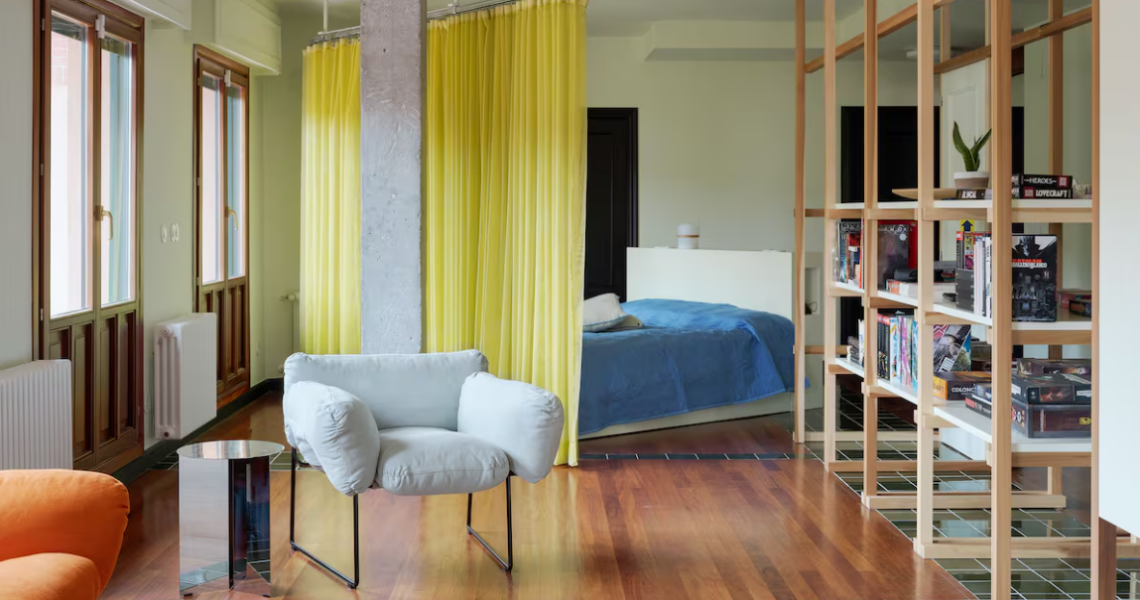How Curtains Can Transform Your Home: From Simple Window Dressing to Spatial Mastery
Curtains are often seen as simple accessories for windows, providing privacy, filtering light, and framing a view. Yet their potential extends far beyond these traditional roles. In contemporary interior design, curtains can radically transform a room, redefining its structure, style, and functionality. Affordable and versatile, they allow homeowners to introduce texture, color, and flexibility without permanent construction.
In the Thinner Wall project by Estudio BeAr, for instance, a bright yellow curtain acts as a soft enclosure within a bedroom, creating spatial divisions without walls. Its diagonal placement transforms a previously open area, allowing it to function simultaneously as a hallway, a sleeping zone, or a breakfast nook. This performative use of curtains highlights their ability to adapt to changing needs, offering privacy, delineation, and visual interest with minimal material and cost. Curtains, in this context, become active participants in shaping the environment, rather than passive decorations.
Masquespacio, a design studio based in Valencia, has explored similar ideas in their home-studio. In this project, curtains go beyond windows: they are theatrical elements, acoustic buffers, and decorative accents. In the patio, seven-meter-high curtains hang in elegant waves, contrasting with the geometric lines of the architecture. Semi-transparent at the upper level, they provide subtle visual connections between private and communal spaces, balancing openness and discretion. Ana Milena Hernández Palacios emphasizes that curtains can be sculptural and dynamic, far more than mere window treatments.
In Spain, privacy is often a primary concern, but designers are reimagining curtains as interior spatial tools. In the homes of Estudio BeAr, curtains separate kitchens from bathrooms, laundry areas, and pantries, offering flexible, low-cost alternatives to permanent partitions. Similarly, in Granada, GRX Arquitectos’ La Casa de las Cortinas uses curtains to allow light to penetrate interior spaces while dividing functions, such as living and dining areas, or a bedroom and workspace. The lightness and mobility of curtains allow for a fluid, adaptable home environment, where occupants control how spaces are activated and perceived.
Laura Ortín calls them “architectural curtains,” integral to a project from the outset rather than decorative afterthoughts. In her projects, curtains define both visual and functional boundaries. In Casa Lab, they create a hotel-like atmosphere in the bedroom, concealing a dressing area and curved doors behind which the bathroom lies. In Casa Mo, pleated felt curtains hide entrances and separate living spaces from bedrooms, providing texture, rhythm, and sculptural presence. Casa Oh! demonstrates the theatrical potential of curtains, with a dramatic curve that blurs the line between interior and exterior, making the balcony an extension of the living space.
Studio Noju’s Casa Triana also showcases the versatility of curtains, using them to transform the living room into a guest bedroom when needed. By drawing or retracting the curtain, the same space can serve multiple purposes, maintaining openness while providing privacy. Beyond traditional fabric, the studio extended the concept of the curtain into solid elements, such as colored niches with metal slats, which mimic the soft, flowing movement of drapery. This approach reinforces a cohesive spatial narrative where every element interacts harmoniously.
Similarly, architect Pepe Lacruz transformed a former garage into a multifunctional “techno-social cellar” for a retired couple. Here, curtains define areas for socializing, dining, dancing, or teleworking. Using a minionda format instead of traditional waves, the drapery complements the surrounding materials, providing both subtle division and visual rhythm. In this project, curtains act as soft structural elements, flexible yet aesthetically coherent, highlighting their potential as tools for both utility and design.
In essence, curtains have evolved from decorative accessories to fundamental architectural elements. They allow designers and homeowners to create dynamic, adaptable environments, combining aesthetics, functionality, and personal expression. Whether through theatrical drapery, acoustic buffers, spatial separators, or sculptural interventions, curtains offer a low-cost, high-impact strategy to redefine and enrich the way we inhabit our homes. By embracing their transformative potential, a simple curtain can change not only a room but the entire experience of living within it.
